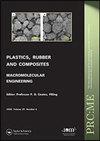Thermal degradation mechanism and thermal life of PMMA/hydroxylated MWCNT nanocomposites
IF 1.2
4区 材料科学
Q3 MATERIALS SCIENCE, COMPOSITES
引用次数: 2
Abstract
ABSTRACT Polymethyl methacrylate/hydroxylated multi-walled carbon nanotubes (PMMA/MWCNT-OH) nanocomposites were prepared by solution blending by adding 1, 2, 3, and 4 wt-% MWCNT-OH. The thermal degradation mechanism and thermal life of PMMA/MWCNT-OH in nitrogen and oxygen atmospheres were investigated in detail. When MWCNT-OH content was 3 wt-%, the maximum thermogray-weight temperature (T m) was 11.5°C and 61.4°C higher than that of PMMA in nitrogen and oxygen atmospheres. Three-dimensional diffusion reaction and level 1.5 chemical reaction in nitrogen atmosphere and one-dimensional diffusion reaction and level 1 chemical reaction chemical reaction in oxygen atmosphere by Achar method and Coats–Redfern method were the possible mechanisms of PMMA and PMMA/MWCNT-OH nanocomposites. When the weight loss rate of 30% was taken as the thermal life end point of the composites, the thermal life first increased and then decreased with the content of MWCNT-OH increased by Kissinger method and Dakin equation.PMMA/羟基化MWCNT纳米复合材料的热降解机理和热寿命
摘要:通过添加1、2、3、4 wt-% MWCNT-OH的溶液共混制备了聚甲基丙烯酸甲酯/羟基化多壁碳纳米管(PMMA/MWCNT-OH)纳米复合材料。研究了PMMA/MWCNT-OH在氮气和氧气环境下的热降解机理和热寿命。当MWCNT-OH含量为3wt -%时,其最大热灰重温度(T m)分别比PMMA高11.5℃和61.4℃。Achar法和Coats-Redfern法在氮气气氛中进行三维扩散反应和1.5级化学反应,在氧气气氛中进行一维扩散反应和1级化学反应是PMMA和PMMA/MWCNT-OH纳米复合材料的可能机理。以失重率30%作为复合材料的热寿命终点时,通过Kissinger法和Dakin方程可知,随着MWCNT-OH含量的增加,复合材料的热寿命先增大后减小。
本文章由计算机程序翻译,如有差异,请以英文原文为准。
求助全文
约1分钟内获得全文
求助全文
来源期刊

Plastics, Rubber and Composites
工程技术-材料科学:复合
CiteScore
4.10
自引率
0.00%
发文量
24
审稿时长
4 months
期刊介绍:
Plastics, Rubber and Composites: Macromolecular Engineering provides an international forum for the publication of original, peer-reviewed research on the macromolecular engineering of polymeric and related materials and polymer matrix composites. Modern polymer processing is increasingly focused on macromolecular engineering: the manipulation of structure at the molecular scale to control properties and fitness for purpose of the final component. Intimately linked to this are the objectives of predicting properties in the context of an optimised design and of establishing robust processing routes and process control systems allowing the desired properties to be achieved reliably.
 求助内容:
求助内容: 应助结果提醒方式:
应助结果提醒方式:


